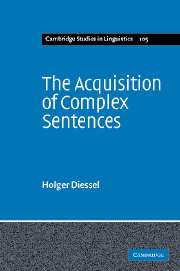Book contents
- Front matter
- Contents
- Figures
- Tables
- Acknowledgements
- Abbreviations
- 1 Introduction
- 2 A dynamic network model of grammatical constructions
- 3 Towards a definition of complex sentences and subordinate clauses
- 4 Infinitival and participial complement constructions
- 5 Complement clauses
- 6 Relative clauses
- 7 Adverbial and co-ordinate clauses
- 8 Conclusion
- Appendix
- References
- Author index
- Subject index
2 - A dynamic network model of grammatical constructions
Published online by Cambridge University Press: 22 September 2009
- Front matter
- Contents
- Figures
- Tables
- Acknowledgements
- Abbreviations
- 1 Introduction
- 2 A dynamic network model of grammatical constructions
- 3 Towards a definition of complex sentences and subordinate clauses
- 4 Infinitival and participial complement constructions
- 5 Complement clauses
- 6 Relative clauses
- 7 Adverbial and co-ordinate clauses
- 8 Conclusion
- Appendix
- References
- Author index
- Subject index
Summary
The theoretical framework used by most researchers of child language development is Chomsky's theory of generative grammar. The theory has changed considerably in recent years. The older model, which is still often used in child language research, is called Principles and Parameters Theory, while the newest version is known as Minimalism (cf. Chomsky 1981, 1986, 1995, 2000). Within this framework, it is commonly assumed that children are born with an innate universal grammar consisting of principles and parameters that define the space within which the grammars of individual languages may vary. Grammatical development is seen as a process whereby the parameters of universal grammar are set to a language-specific value by linguistic triggers in the input.
The theoretical framework used in this study is very different; it is based on recent work in functional and cognitive linguistics. The functional–cognitive approach subsumes a variety of related frameworks (cf. Croft 1995; Newmeyer 1998). Two of them are especially important to the current investigation: construction grammar, and the usage-based model. Construction grammar subsumes a family of grammatical theories in which constructions are considered the basic units of grammar (cf. Fillmore, Kay, and O'Connor 1988; Lakoff 1987; Langacker 1987a; Fillmore and Kay 1993; Goldberg 1995; Croft 2001); and the usage-based model comprises various network models in which linguistic knowledge is shaped by language use (cf. Bybee 1985, 1995, 2001; Langacker 1987a, 1991; Barlow and Kemmer 2000; Elman, Bates, Johnson, Karmiloff-Smith, Parisi, and Plunkett 1996).
- Type
- Chapter
- Information
- The Acquisition of Complex Sentences , pp. 13 - 40Publisher: Cambridge University PressPrint publication year: 2004
- 1
- Cited by



